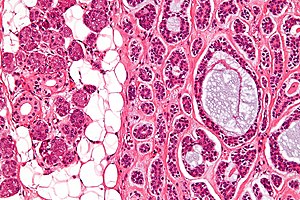Adenoid cystic carcinoma
Jump to navigation
Jump to search
The printable version is no longer supported and may have rendering errors. Please update your browser bookmarks and please use the default browser print function instead.
| Adenoid cystic carcinoma | |
|---|---|
| Diagnosis in short | |
 Adenoid cystic carcinoma. H&E stain. | |
|
| |
| LM | cribriform architecture (other patterns: solid, cords, (bilayered) tubules), cystic spaces filled with basophilic material, scant cytoplasm in most cells, nucleus - small, hyaline stroma |
| LM DDx | pleomorphic adenoma, epithelial-myoepithelial carcinoma, intraductal carcinoma |
| Site | salivary gland, breast, lung, skin, trachea, others |
|
| |
| Signs | mass |
| Prevalence | relatively common malignant salivary gland tumour |
| Treatment | surgical excision |
Adenoid cystic carcinoma, abbreviated AdCC, is a malignant tumour commonly seen in the salivary gland.
General
- Common malignant neoplasm of salivary gland.[1]
- May occur in the skin.[2]
- AKA cylindroma.[3]
- Should not be confused with dermal cylindroma (a benign skin tumour).
- Composed of ductal cells and myoepithelial cells; myoepithelial cells > ductal cells.
Microscopic
Features:
- Cribriform architecture or pseudoglandular spaces (classic pattern) - important feature.
- Other patterns: solid, cords, (bilayered) tubules.
- Cystic spaces filled with basophilic material (that is PAS +ve) - key feature.
- Scant cytoplasm in most cells (myoepithelial cells) - clear/eosinophilic.
- Moderate eosinophilic cytoplasm in the (rare) ductal cells.
- Nucleus - small.
- May be angulated (carrot-shaped) - myoepithelial cells; round/ovoid in ductal cells.
- Hyaline stroma.
Memory device:
- AdCC - mostly DNA (scant cytoplasm), distinct nucleus (carrot-shaped).
Notes:
- Squamous differentiation is extremely rare. It presence should prompt consideration of:
- Basaloid squamous cell carcinoma.
- Basal cell carcinoma (BCC).
- Perineural invasion is usually present.
- If it is not one should consider other diagnoses.
DDx:
- Pleomorphic adenoma, esp. if encapsulated.
- Epithelial-myoepithelial carcinoma - esp. for AdCC tubular variant.
- Human papillomavirus-related multiphenotypic sinonasal carcinoma (previously known as human papillomavirus-related carcinoma with adenoid cystic-like features).
- Intraductal carcinoma of the salivary gland.
Images
AdCC trachea - low mag.
Grading
Based on solid component:
- Low grade = tubules and cribriform structures only; no solid component.
- Intermediate grade = solid component <30%.
- High grade = solid component >=30%
Stains
Special stains:
- PAS +ve material - cystic spaces.[4]
IHC
Features:[5]
- CD117 +ve.
- Cyclin D1 +ve/-ve.
Others:[6]
- CK7 +ve.
- Pankeratin +ve.
- p63 +ve.
- Calponin +ve.
- S-100 +ve.
Note:
- Myoepithelial markers (e.g. calponin, actin) +ve.
- Typically -ve in PLGA.
Molecular
Features:[7]
- t(6;9) MYB-NFIB.
- Seen in ~50% of cases.
- Worse prognosis if present, esp. if fusion assoc. with transcription.
Sign out
Micro
The sections show a tumour with a cribriform architecture. The cystic spaces have basophilic material. The tumour cells are carrot-like and have scant/modest cytoplasm.
See also
- Salivary glands.
- Adenoid cystic carcinoma of the breast.
- Adenoid cystic/basal cell carcinoma of the prostate.
- Head and neck pathology.
- Head and neck cytopathology.
References
- ↑ Krüll, A.; Schwarz, R.; Engenhart, R.; Huber, P.; Lessel, A.; Koppe, H.; Favre, A.; Breteau, N. et al. (1996). "European results in neutron therapy of malignant salivary gland tumors.". Bull Cancer Radiother 83 Suppl: 125-9s. PMID 8949764.
- ↑ Wick, MR.; Swanson, PE. (Feb 1986). "Primary adenoid cystic carcinoma of the skin. A clinical, histological, and immunocytochemical comparison with adenoid cystic carcinoma of salivary glands and adenoid basal cell carcinoma.". Am J Dermatopathol 8 (1): 2-13. PMID 3010759.
- ↑ Chest. May 1957. Vol. 31. No. 5. PP. 493-511. http://www.chestjournal.org/content/31/5/493.abstract
- ↑ URL: http://www.pathconsultddx.com/pathCon/diagnosis?pii=S1559-8675%2806%2970070-5. Accessed on: 12 May 2011.
- ↑ Sequeiros-Santiago, G.; García-Carracedo, D.; Fresno, MF.; Suarez, C.; Rodrigo, JP.; Gonzalez, MV. (May 2009). "Oncogene amplification pattern in adenoid cystic carcinoma of the salivary glands.". Oncol Rep 21 (5): 1215-22. PMID 19360297.
- ↑ Thompson, LD.; Penner, C.; Ho, NJ.; Foss, RD.; Miettinen, M.; Wieneke, JA.; Moskaluk, CA.; Stelow, EB. (Sep 2013). "Sinonasal Tract and Nasopharyngeal Adenoid Cystic Carcinoma: A Clinicopathologic and Immunophenotypic Study of 86 Cases.". Head Neck Pathol. doi:10.1007/s12105-013-0487-3. PMID 24037641.
- ↑ Mitani, Y.; Rao, PH.; Futreal, PA.; Roberts, D.; Stephens, P.; Zhao, YJ.; Zhang, L.; Mitani, M. et al. (Oct 2011). "Novel Chromosomal Rearrangements and breakpoints at the t(6;9) in Salivary Adenoid Cystic Carcinoma: association with MYB-NFIB chimeric fusion, MYB expression, and clinical outcome.". Clin Cancer Res. doi:10.1158/1078-0432.CCR-11-1870. PMID 21976542.










